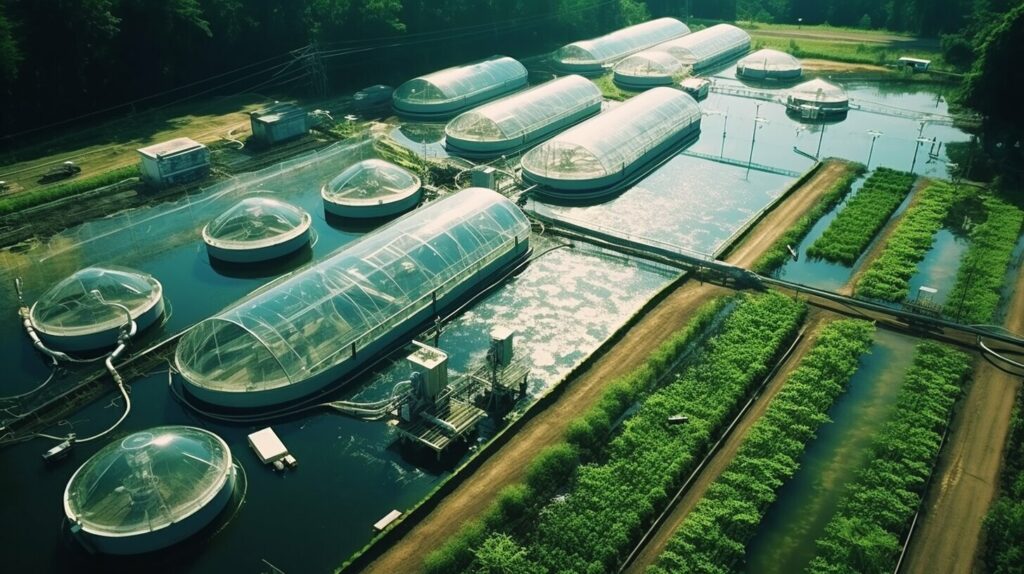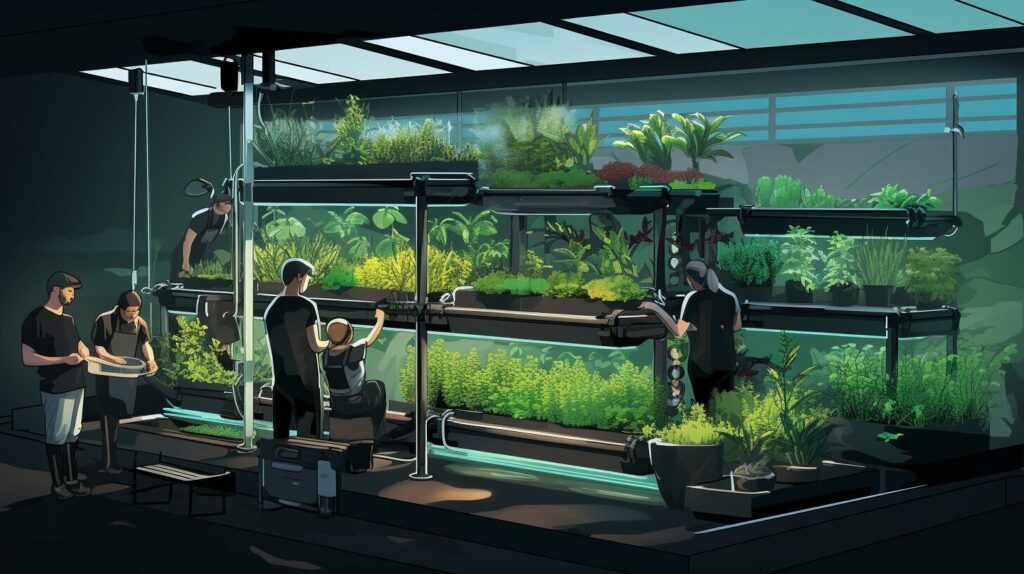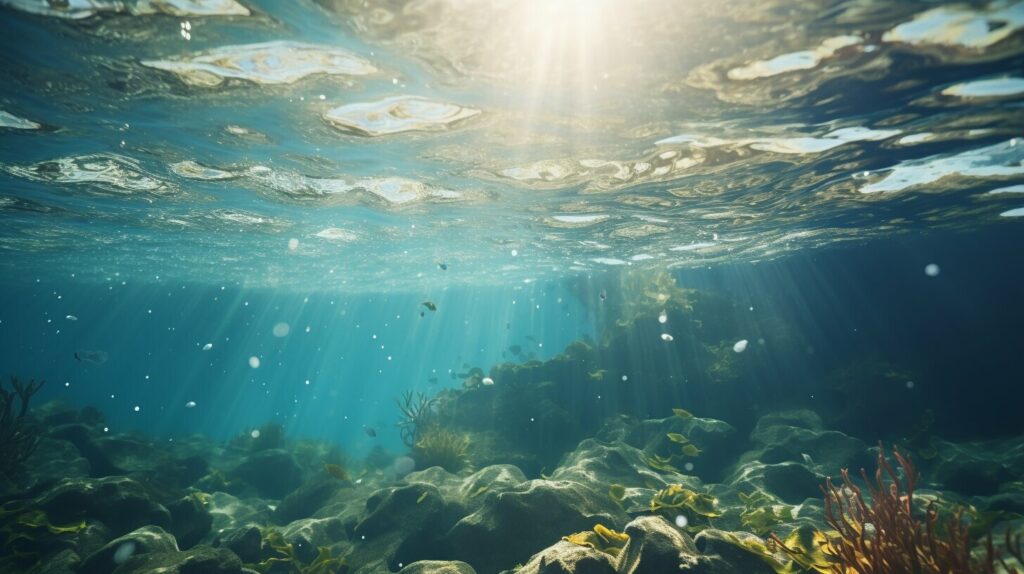This post may contain affiliate links and we may earn a small commission when you click on the links at no additional cost to you. As an Amazon Affiliate, we earn from qualifying purchases. You can read our full disclaimer here.
Do you wonder how we can grow food sustainably while conserving our precious water resources? Did you know aquaponics — a mix of hydroponic plant cultivation and fish farming, has the potential to be a significant solution to this global issue? This blog post will take you on an enlightening journey through the ecological principles of aquaponics, showing its numerous benefits and considerations.
Dive in and uncover the magic beneath this promising sustainable food production system!
Key Takeaways
- Aquaponics is a sustainable way to grow food using fish and plants. The fish waste gives nutrients to the plants, and the plants clean the water for the fish.
- Beneficial bacteria in an aquaponic system turn harmful ammonia from fish waste into nitrates, which feed the plants.
- An aquaponics system uses less water than traditional farming because it keeps recycling water. It also does not use chemical fertilizers or pesticides.
- Maintaining a balanced ecosystem is crucial in aquaponics. This includes closely monitoring things like water quality, temperature and pH levels.
What is Aquaponics?
Aquaponics is a sustainable farming method that combines aquaculture and hydroponics in a symbiotic environment. Aquaculture, the practice of raising aquatic creatures such as fish, snails or prawns in tanks, collaborates with hydroponics – cultivating plants in water devoid of soil.
In this innovative agricultural setup, waste from the aquatic species serves as natural nutrients to stimulate plant growth.
Bacteria play a pivotal role in an aquaponic system by breaking fish waste into nitrates. Plants utilize these nitrates for their development while simultaneously purifying the water for fish.
The cycle repeats itself, providing nutrient-rich conditions for fish and plant production. This self-contained ecosystem doesn’t need additional fertilizers or pesticides, making it an excellent model for sustainable food production.
The Ecological Principles of Aquaponics
In aquaponics, the ecological principles are nutrient recycling, beneficial bacteria utilization, natural pest control, and efficient use of resources. Nutrient recycling occurs as fish waste transforms into plant nutrients through a biological process.
Beneficial bacteria are crucial in breaking down this waste and making it readily available for plant absorption. Natural pest control is achieved because the system’s closed-loop design diminishes the need for harmful pesticides or herbicides.
Lastly, aquaponics promotes efficient resource use by maximizing water efficiency and reducing land use compared to conventional farming methods; you save water as it continually recirculates within the system while also being able to grow more crops per square foot!
Nutrient recycling
Nutrient recycling is a vital component of an aquaponics system. In this process, the waste produced by fish is a natural fertilizer for plant growth. Aquaponic systems leverage this cycle by filtering out particulates and converting ammonia from the fish waste into safe levels of nitrates, helping nourish plants in return.
This efficient circulation of nutrients reduces the need for synthetic fertilizers and conserves water. The constant recirculation cleans and purifies the water while continuously enriching it with minerals.
It’s a win-win situation – healthy fish produce nutrient-rich waste, which promotes robust plant growth and filters the water, creating ideal conditions for more productive aquaculture farming.
Beneficial bacteria
Beneficial bacteria play a stellar role in aquaponics systems. They function as middlemen between fish and plants by converting the waste material from the fish into nutrients essential for plant growth.
It’s an ingenious process called nitrification, carried out by two types of bacteria: Nitrosomonas and Nitrobacter.
Nitrosomonas first use ammonia, a toxic product found in fish waste, and convert it to nitrite. Following this conversion, Nitrobacter changes nitrites into nitrates – a more beneficial compound that plants can readily absorb as food through their roots.
With these microscopic heroes diligently doing their job, your aquaponic system remains healthy and efficient!
Natural pest control
Natural pest control is an essential part of an aquaponics system. This method promotes the growth of beneficial insects that prey on harmful pests, eliminating the need for chemical pesticides.
For instance, ladybugs and other predator bugs help keep aphids and mites at bay in aquaponic environments. The plants also benefit from this, as they thrive without exposure to harsh chemicals traditionally used in pest control.
In a well-designed aquaponics system, these natural predators contribute significantly towards maintaining a healthy balance within the ecosystem. By nurturing such rich biodiversity within your setup, you’re helping preserve nature’s delicate balance and ensuring healthier and safer food production for everyone involved.
Moreover, implementing natural pest control techniques can be cost-effective because it reduces the need to purchase expensive chemical products that might even harm your fish and plants if misused or overused.
Therefore, taking advantage of nature’s systems for controlling pests is another reason many people find aquaponics more appealing than traditional farming methods.
Efficient use of resources
In an aquaponic system, resources like water and nutrients get effectively used to their fullest potential. The closed-loop design recycles water from the fish tank to the plant bed, reducing water use by nearly 90% compared to traditional farming methods.
Fish waste is a natural fertilizer for plants, negating the need for harmful chemical fertilizers and making it a sustainable food production method. Not only does efficient resource use contribute to cost savings in aquaponic farming, but it also supports environmental conservation initiatives regarding minimal waste generation.
Plant growth thrives with lower energy demands due to the readily available nutrients within the system, resulting in high-yield crops.
Benefits of Aquaponics
Aquaponics promotes sustainable farming as it reuses water and reduces waste. This method results in higher crop yields without harmful pesticides or fertilizers. It lowers environmental impact by consuming less land, water, and energy than conventional farming methods.
Not only does it contribute to food security, but it also offers a unique solution for urban agriculture where space is typically limited. Aquaponic systems are versatile and can be scaled according to need – from small home setups to large commercial operations.
With aquaponics, you’re not just growing plants but nurturing an entire ecosystem that works together for healthier produce.
Sustainable farming practices
Through aquaponics, you contribute directly to sustainable farming practices. This unique method of growing crops and fish together in a cooperative environment reduces the need for large plots of land and heavy water use.
Unlike traditional agriculture, which degrades soil over time, aquaponics enriches its aquatic ecosystem with every cycle. Additionally, it uses up to 90% less water than conventional farming methods due to its recirculating nature.
You not only save precious resources but also grow food all year round without depending on weather conditions or soil fertility levels.
Higher crop yields
Aquaponics can significantly boost crop yields compared to traditional farming methods. This sustainable farming practice leverages the symbiotic relationship between fish and plants, optimizing conditions for both components.
The nutrient-rich water from the fish tank circulates through a hydroponic system where the plant roots absorb these beneficial nutrients, promoting faster growth and higher production rates.
Therefore, adopting aquaponics reduces environmental impact and supports enhanced food security with its superior vegetable and fish production capacities within a compact space.
Reduced environmental impact
Aquaponics stands out as a sustainable farming method that significantly lessens environmental impact. Utilizing a closed-loop system dramatically reduces water usage compared to traditional agriculture and hydroponics because the water is continually recycled.
Aquaponic farms don’t require synthetic fertilizers and pesticides, which can cause pollution when they seep into ground or surface waters. This form of cultivation also opens up potential for local food production in urban areas, leading to decreased transportation emissions associated with delivering fresh produce from remote farms to city supermarkets.
Challenges and Considerations in Aquaponics
Despite the numerous benefits of aquaponics, it’s essential to acknowledge potential challenges. Water quality must be monitored and maintained for optimal fish and plant health.
Balancing your ecosystem is crucial – one small change can significantly impact all life forms in the system. Temperature and pH levels also require consistent management as they affect nutrient availability and disease prevalence.
Setting up an effective aquaponic system demands careful planning, precise adjustments, and regular upkeep to ensure its success.
Maintaining water quality
Keeping the water clean in your aquaponics system is crucial. Dirty water can harbor harmful bacteria and algae, leading to health issues for both fish and plants. Regularly monitoring nitrate levels helps ensure enough nutrients are available for plant growth without contaminating the system.
Installing a recirculating aquaculture system can also help maintain optimal water quality by filtering out debris and returning fresh, oxygenated water into the tank. This protects your fish from diseases and promotes more robust vegetable production in sustainable farming practices.
Balancing the ecosystem
A thriving aquaponics system hinges on having a balanced ecosystem. It’s an intricate dance between the setup’s fish, plants and bacteria. The fish produce waste, which turns into ammonia – quite harmful if left untreated.
However, beneficial bacteria convert this ammonia into nitrates that fertilize your plants. These growing plants absorb these nutrients, cleaning the water that cycles back to your aquatic friends.
Careful monitoring is crucial to ensure each component of this ecological trifecta stays healthy and functional, maintaining harmony in your aquaponic haven.
Managing temperature and pH levels
In an aquaponics system, careful management of temperature and pH levels significantly aids in maintaining a healthy environment for fish and plants. Too high or too low temperatures can distress the fish, hinder plant growth, and disrupt beneficial bacteria’s functioning.
Properly balanced pH ensures optimal nutrient absorption by plants and promotes overall system health. Heaters or coolers help regulate water temperature, while buffers can adjust pH levels.
Regular monitoring and adjusting these parameters are vital to keep your aquaponics operation thriving.
Successful Examples of Aquaponics Systems

Discover how commercial farms, community projects, and even home-based setups have successfully adopted aquaponics to grow fresh, sustainable food.
Commercial aquaponics farms
Commercial aquaponics farms stand out as a sustainable and highly productive farming method. These operations, often serving local communities, utilize an intricately balanced ecosystem between fish and plants to promote healthy growth.
Reduced water usage is a key benefit that attracts farmers, considering how the system recycles water for efficient use. International studies have pointed towards promising economic viability for commercial aquaponics, showcasing its global potential to enhance food security.
Further adding value are sales from non-food products associated with these farms, boosting their profitability.
Community and home-based systems
Community and home-based aquaponics systems are changing how we grow food in urban environments. These setups require less space than traditional gardens, making them perfect for city dwellers with limited outdoor areas.
They also use up to 90% less water, contributing to conservation efforts. Families and communities can grow fresh produce year-round, reducing reliance on imported goods.
This system is economical and educational, providing a practical learning opportunity about sustainable farming practices. The fish cultivated in these tanks serve dual purposes; they act as a source of protein while their waste feeds the plants above.
Schools across America are incorporating small-scale aquaponics units into their curriculum to teach students about environmental science and responsible food production methods. Even restaurants have started growing herbs and vegetables onsite using this method – giving new meaning to farm-to-table dining! With community support and shared knowledge, these systems can help promote local agriculture by transforming balconies, rooftops, basements or backyards into productive mini-farms.
Commercial enterprises are taking note, too; companies specializing in home-based aquaponics products offer ready-to-use kits that beginners can easily set up. These range from simple countertop herb planters powered by a single betta fish to larger freestanding units capable of producing substantial quantities of organic vegetables and fish.
So whether it’s for personal consumption or broader education goals – community and home-based aquaponics brings sustainability right to our doorstep.
Conclusion
Aquaponics unveils an innovative and sustainable approach to food production, harnessing nature’s processes. It goes beyond simple fish and plant cultivation, creating a synergistic ecosystem that maximizes resource efficiency.
Understanding and applying the ecological principles in this system design can revolutionize our farming practices for a healthier planet. Embracing aquaponics means choosing responsible stewardship of the earth’s resources while reaping abundant yields.



